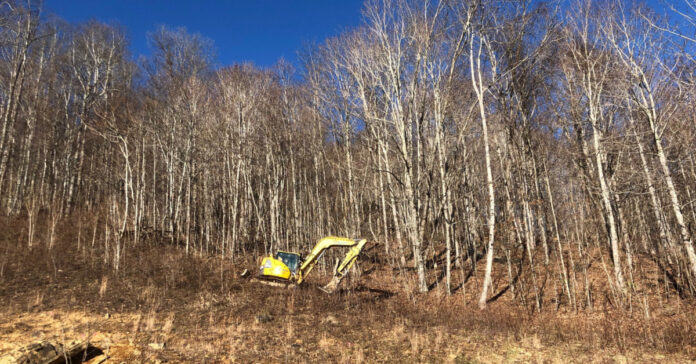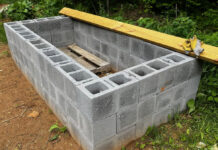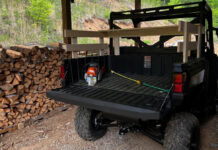Finally! After waiting months, our water pipes are now buried and we should be in good shape to withstand the coming blast of bitter cold weather.
The pipes in question run from the spring up the mountain for 800 feet to a storage tank. The tank is 165 feet above the house, which is what gives us water pressure. Before burying them, the pipes lay on the top of the ground, exposed to the weather and animals. Sometimes when they froze, the ice would just plug up the pipe, cutting off our water. Other times, the pipe, which is a black polyethylene, would split. Of course, a split would become a leak when things thawed back out, and we’d lose most of our water.
Now the pipes are a couple feet underground. I say “pipes” because in addition to burying our original pipe, we installed and buried a second pipe as a backup. The thinking is if we run into a problem with the first pipe, we can switch pipes and still get water.
This weekend will be the big test as we expect temperatures around zero and wind chill temperatures far colder. The wind chill will never reach those pipes now.
Protecting Your Water Pipes
I spent enough years in the Great White North to know that even pipes inside your house can freeze. It happened to me twice when I was younger. Besides keeping your house warm, the best way I’ve found to protect your pipes is to open the cabinets below your sinks, especially for a sink that is on an exterior wall.
As the wind blows and the wall of your house gets cold, the air in the cabinet under the sink will also grow colder. Some areas of the Midwest are expecting wind chills that could reach -50°F Thursday or Friday night, and most houses are not built to withstand those temperatures. If the cabinet doors are closed, the warmer air from inside your home won’t be able to circulate under the sink. Leaving the cabinet open will help prevent the pipes from freezing.
Many people recommend leaving the water dripping. I’m not convinced that is a successful strategy. My thinking is it may not prevent your pipes from freezing, but it may reduce the chance of the ice expanding to the point where it breaks the pipe. I prefer to run a substantial amount of water through each faucet every hour or two. You want to remove the cold water from the pipes and replace it with ground-temperature water.
Running the hot water will also help prevent your pipes from freezing. If you run the hot water until it flows out the faucet hot, it will heat the pipe. That will act as a radiator under the sink and int he walls and floors. That might raise the temperature enough to prevent the pipes from freezing. Of course, you must have hot water, which means power, for this to work.
Beyond the sub-zero temperatures, the big danger is blackouts caused a very high power load. As every heater and furnace on the grid runs full time, it could stress the power generation and distribution systems. We can hope that having businesses closed by the snow or for the holiday will reduce the power draw and leave enough to meet residential demand. As I suggested earlier in the week, you may want to make sure your backup generator is ready and working.
Freezing Pipes
While a frozen pipe can crack and leak, requiring a repair, the real danger from frozen pipes is the possibility they will burst and water will pour out, flooding the room and causing further property damage. If the power is out for hours and the house is heading towards 32 degrees, turn off the main water supply to your house and drain your pipes. Look there for a shut-off valve on the pipe from the water main comes into your house. It may be in the basement or crawl space. If you have a well, it should stop pumping when the power goes out.
Once your water supply is off, open a few faucets on the top floor of your house and then open a few faucets in the main level and basement. Most of the water in the pipes will flow towards the lower floors and out those faucets. Even if you don’t get it all, you won’t have a catastrophic flood. If the inside temperatures hit freezing, flush your toilets to drain the water and protect them.
If you proactively decide to winterize a building, you drain the water as above and then attach an air compressor to the pipe and send pressurized air through the system to blow out any remaining water. It might be worth winterizing any outbuilding with water, such as a garage, garden shed, cabin or other structure. Also disconnect and empty the water from any hoses, like those attached to the washer and the ice maker in the fridge.
Yes, it is Winter
It’s the winter solstice, the shortest day of the year, so cold shouldn’t surprise us. But this isn’t your average cold, or even your average “bomb cycline.” The National Weather services is calling it a “once in a generation” storm. Sure, it gets cold in the winter, but people in places like Mississippi and Alabama are neither used to nor prepared for single-digit temperatures. 246 people in Texas died in 2021 as a result of the Valentine’s Day cold wave, with 161 dead from exposure to the cold. Yes, they literally froze to death, and that could happen again. This storm will reach into Texas, but it’s going to be far colder in the middle of the country.
People in the Dakotas, Minnesota, Michigan, and other places where cold weather is a common occurrence don’t have as much to worry about. Their houses are built to withstand it, as is the power generation and distribution system. They have warm clothes, insulated boots, and may even plug in their cars. It is places where this kind of cold is rare that are in the greatest danger. If you aren’t used to the cold, this is your last chance to prep for it. At the very least, have wool socks, thermal underwear, a knit cap, and some winter gloves.
Video of the Day
Here’s a video from one of my favorite weather guys. The visual that shows the cold reaching deep into the south starts around 8:45. Check his channel for updates.







